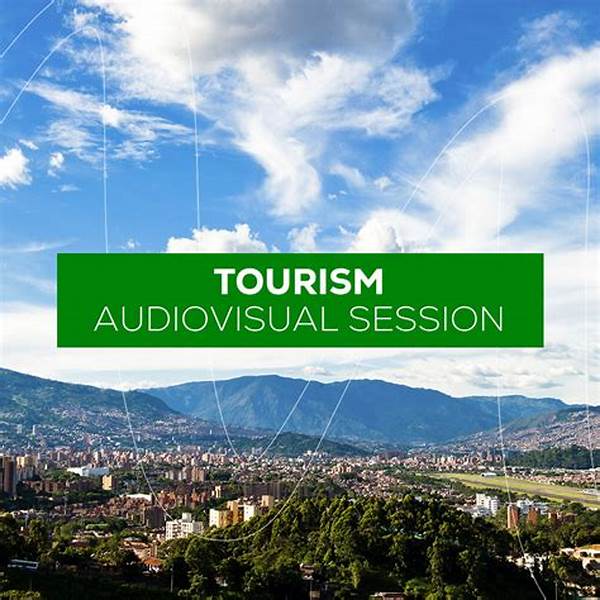Imagine being able to traverse the lush rainforests of Costa Rica, dive into the cerulean waves of the Maldives, or explore the bustling streets of Tokyo without moving an inch from your couch. Audiovisual media has redefined how we experience the world around us, bringing the vastness of the globe into our living rooms. This innovative approach not only satisfies the wanderlust of the curious soul but also serves as a powerful promotional tool for tourism destinations aiming to attract visitors with captivating stories and stunning visuals.
Read More : Benefits Of Audiovisual Sources In Historical Research Making History Personal
Audiovisual media taps into the unique selling propositions of destinations, highlighting their cultural richness, natural beauty, and vibrant urban life through a cinematic lens. Today, the confluence of storytelling and technology offers an unparalleled opportunity for destinations to engage potential tourists on an emotional level. Whether it’s through a feature film, a documentary, or an artfully crafted vlog, the potential to intrigue, inspire desire, and spur action is immense.
Captivating Narratives in Tourism
Cinematic storytelling can transform a simple vacation destination into an alluring adventure. The key lies in creating an emotional connection with the audience through visually striking images paired with compelling narratives. As viewers, we find ourselves riveted by the stories of people, the history behind architectural marvels, or the breathtaking dance of sunlight on a pristine beach—all elements that can be effectively captured through audiovisual media.
Examples of Audiovisual Media Showcasing Tourism Destinations in Cinematic Ways
1. Movies and Feature Films: Perhaps one of the most impactful examples of audiovisual media showcasing tourism destinations in cinematic ways is through feature films. Movies like “The Lord of the Rings” have put New Zealand’s enchanting landscapes on the global map, transforming them into must-visit locales. Similarly, the romantic allure of Paris is often reinforced by movies like “Midnight in Paris,” drawing visitors to its iconic landmarks.
2. Documentaries and Travel Shows: Documentaries and travel shows provide more than just entertainment; they delve deeper into the cultural intricacies and historical contexts of destinations. Series like “Planet Earth” and “Parts Unknown” with Anthony Bourdain have educated audiences about the world’s diverse ecosystems and culinary treasures, creating a new wave of informed and enthusiastic travelers.
3. Vlogs and Online Content: The rise of social media and video blogging has democratized audiovisual content creation, allowing everyday travelers to share their adventures with global audiences. Platforms like YouTube and Instagram host countless travel vlogs that offer personal and often humorous takes on destinations, making them more relatable and accessible to potential tourists.
The Power of Visual Storytelling
Visual storytelling is an essential component in converting interest into action. By crafting narratives that highlight the experiences and emotions associated with a place, audiovisual media has the power to move viewers from passive interest to active decision-making.
Emotional Engagement and Impact
Audiovisual media appeals to both the rational and emotional aspects of decision-making. Engaging visuals paired with emotive storytelling can influence perceptions, preferences, and ultimately, the decision to visit a destination. For instance, a beautifully shot video of the Northern Lights can evoke feelings of wonder and urgency, prompting viewers to book a trip to witness the phenomenon in person.
Building Authentic Connections
Authenticity in storytelling fosters trust and engagement. Media that showcases genuine interactions with locals or highlights the preservation of tradition and culture resonates deeply with audiences. This authenticity not only enhances the credibility of the destination but also builds an emotional bridge between the viewer and the experience on offer.
Read More : Tips For Choosing Audiovisual Lighting For Concert Stages
Effective Marketing Through Audiovisual Media
The integration of audiovisual media in marketing strategies is no longer optional but essential for destinations looking to stand out in a competitive market. Here’s how destinations are leveraging audiovisual content to boost tourism:
Expanding Opportunities in Tourism Promotion
1. Virtual Reality (VR): VR technology offers an immersive way to explore destinations before physically visiting them. Potential tourists can virtually walk through a resort, experience a local festival, or even trek a mountain—all from the comfort of their homes.
2. Augmented Reality (AR): Similarly, AR can enhance on-site tourism experiences by overlaying digital information onto the physical world. Tourists can use their smartphones to learn more about historical sites or navigate through a new city.
3. 360-degree Videos: These videos offer a panoramic view, allowing viewers to experience locations from every angle. It provides an immersive experience that standard videos cannot match and is particularly effective on platforms like YouTube.
Conclusion: An Invitation to Explore
In conclusion, examples of audiovisual media showcasing tourism destinations in cinematic ways are abundant and diverse. By blending technology with narrative storytelling, these media offer compelling reasons to explore new places and cultures. As technology continues to evolve, the potential for more innovative and engaging tourism promotion grows, promising a future where exploring the world is only a click away. Whether you are a casual traveler or an ardent adventurer, the cinematic portrayal of destinations can inspire your next journey, inviting you to step out and make those stories a reality. The world awaits!
